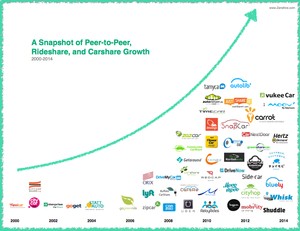 I received a thoughtful reader response from Jeff Conklin on my recent Zopa case study/update. Jeff wrote:
I received a thoughtful reader response from Jeff Conklin on my recent Zopa case study/update. Jeff wrote:
“Your piece about Zopa (which I hadn’t heard of) is fascinating, and reminds me of a quote I saw on LinkedIn yesterday:
‘In 2015 Uber, the world’s largest taxi company, owns no vehicles; Facebook, the world’s most popular media owner, creates no content; Alibaba, the most valuable retailer, has no inventory; and Airbnb, the world’s largest accommodation provider, owns no real estate.’ (Marcella Shinder, Nielson)
It sounds like a Zopa-like company might become the world’s largest lender (investor?), without any capital.
What is going on here? It appears there’s a whole new niche in the economy for P-to-P coordination at scale. Is there a name for that niche? What does it look like when you take that model to its logical limit? Does it make large companies at risk of being replaced by networks of independent agents supported by coordination apps (i.e., Uber and taxi companies)?”
I agree with Jeff’s observation that something profound is going on here.
P2P in Finance. I just returned from Africa, where P2P money-swapping via mobile phones is ubiquitous. The primary form of banking for most families is Savings and Credit Associations (SACCOs) that are formed by groups of villagers in every community. People put in a few dollars each week, and borrow money at interest from the kitty when they want to buy a pig or fix their roof. At the end of each year, the profits are distributed out based on the amount each person has saved/invested. This tried and true model has been flourishing for decades in third world countries. Zopa and other online savings and loan enterprises around the world are an electronic equivalent of a “spread the risk” model that has been well-proven.
Every mobile network in Uganda lets you move money from your phone to someone else’s phone.

MTN Mobile Money is just one of several mobile phone P2P money transfer services.
P2P in Transportation. In addition to Uber and its competitors (such as Lyft), in which people provide a taxi service by driving their own cars as taxis for hire, there’s a rental car model in which people rent out their unused cars for others to drive. Buzzcar was launched in France by ZipCar founder Robin Chase, and recently merged with Drivy. Over 26,000 people, who have cars sitting idle during part of the day or week, make them available for rental by 500,000 people who need cars to run errands or go to a meeting.
Robin Chase launching Buzzcar in France.
In rural areas of the country, it’s often hard to get access to transportation, especially for those too old to drive safely. Yet many people are out of work; some of them are lucky enough to still have a car at their disposal. They can earn tax-free income by driving these elderly shut-ins, and get reimbursed for their mileage, which, in turn, pays for the upkeep, gas, and insurance on their cars.
Rideshare and CarShare Growth, courtesy of Zendrive.
P2P in Accommodation. For centuries, people have been opening rooms in their own homes to strangers as rentals. Now, thanks to the Internet, it’s much easier to find and book these spare rooms. AirBnB is one Internet instantiation of a practice that has been going on for centuries. By making the inventory visible online, and mitigating much of the risk, P2P rooms for rent are turning unused space into income for many families.
Families have also been swapping homes for quite a while. Our own Susan Aldrich recently returned from travelling the world, courtesy of house and pet sitting in many countries that she and her husband were eager to visit.
Need a place to stay in Singapore? Courtesy of AirBnB.
P2P in Work-Sharing. In my small town in Maine, barter is a way of life. You swap something you have for the work you need to get done. Lobsters for carpentry; a backhoe for a day in exchange for some felled trees that can be converted into firewood; snowplowing in exchange for getting a computer fixed. This is the way the world has always worked. But, now, as jobs are scarce and cash isn’t always readily available, there’s a decided uptick in bartering.
P2P in Time-Banking. There are many ways to automate bartering through online bulletin boards and services. One of my favorite approaches takes value out of the equation and turns bartering services into legally non-taxable events. There are Time Banks all over the world. In my community, we use Time Initiative of Maine to swap volunteer hours. Since there are lots of retirees, semi-retirees, and part-time or seasonal workers and a disproportionate number of non-profits doing good works, people log their volunteer time and receive services in exchange. You take a shut-in neighbor grocery shopping and log those 2 hours, and someone else will come by and spend two hours chopping wood for you.
P2P in Education. Home schooling has become very popular throughout the U.S. Once practiced primarily by people with strong religious beliefs, now parents of all creeds are deciding that they can do a better job of educating their kids than their overburdened local schools. But some parents are better at math and science and others at writing and literature. Some parents excel in sports and fitness. Others can teach organic gardening. So the norm among home-schoolers is to create on-demand curricula by mixing and matching these services.
Where else are you seeing P2P in your life and communities? Is the P2P business model providing valuable options in your daily life?
Is P2P Growing?
Yes! Thanks to the Internet and to our ability to access the Net via our mobile phones thru the Web, SMS, and mobile Apps, there are literally hundreds of industries in which people are providing information, goods, and services directly to one another. If you add voluntary content creation to the P2P model, as Marcella Shinder of Nielsen suggests (in the quote above) in lumping Facebook into the mix, then the P2P industry is huge!
Is P2P a Threat to Traditional Business Models?
What’s the answer to Jeff Conklin’s question:
“Does it make large companies at risk of being replaced by networks of independent agents supported by coordination apps?”
I believe that traditional business models will co-exist in parallel with P2P business models. However, the P2P options will have a profound impact on the profit margins that traditional players will be able to extract. If you can rent a room in a lovely home on a quiet street for $50/night with Wifi and good coffee, fruit and yogurt, why would you pay $250/night at the commodity hotel down the road?
P2P Native Businesses Will Experience High Growth. Hundreds of start-ups will continue spawn P2P businesses in virtually every industry (and create new industries). P2P coordinators will provide visibility, risk-sharing, recourse, and gain valuable insights. They will profit in the traditional manner, by being first to market, building and maintaining customer/supplier loyalty, providing transparency, having ethics that customers value, and being agile and evolving quickly. If I were investing in new companies today, I’d favor P2P businesses.
P2P Inclusive Businesses Will Keep Margins Down and Value Up. Smart traditional companies already leverage P2P as an integral part of their businesses in order to reduce costs and increase value.
One of the most obvious places we see P2P integrated into traditional businesses is customer support. Knowledgeable customers typically provide better, more relevant, and more current help to one another for free than any set of highly paid experts. So nurturing your customers, acknowledging and rewarding them for the free service they provide, is well worth the care and attention required to keep them happy and contributing.
Another good example is customer-created designs and content. Zazzle sells custom printing services of millions of customer-created designs. If the company hadn’t promoted the ability for customers to create their own designs and make those available to others to re-use or customize, Zazzle would have remained a niche custom-printing house, rather than a leader in that industry.
What other examples have you seen, in which traditional companies have embraced P2P successfully?







